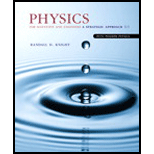
Concept explainers
(a)
The isotopes from the given atoms
Answer to Problem 1CQ
Solution:
Isotopes are
Explanation of Solution
Isotopes are atoms having the same atomic number (Z) but having the different mass number (A). In our case, both
Conclusion:
Atoms having a same atomic number (Z) are known as isotopes.
(b)
The isobars from the given atoms-
Answer to Problem 1CQ
Solution:
Isobars are
Explanation of Solution
Isobars are atoms having the different atomic number (Z) but having the same mass number (A). In our case,
Conclusion:
Atoms having a same mass number (A) are known as isobars.
(c)
To determine the atoms having same chemical properties from the given atoms.
Answer to Problem 1CQ
Solution:
Atoms having the same chemical properties are
Explanation of Solution
Conclusion:
Chemical properties of isotopes of the same element are same.
(d)
To determine the atoms having the same number of neutrons from the given atoms.
Answer to Problem 1CQ
Solution:
Atoms having the same number of neutrons are
Explanation of Solution
As we know in an atom n + p = A where n is the number of neutrons, p is the number of protons and A is the mass number. Also, the number of protons in an atom is equal to its atomic number. So, we can say n + Z = A. So, the number of neutrons is equal to mass number (A) – atomic number (Z). In case of
Conclusion:
Atoms having the same difference in the mass number (A) and atomic number (Z) will have the same number of neutrons.
Want to see more full solutions like this?
Chapter 42 Solutions
Physics for Scientists and Engineers: A Strategic Approach with Modern Physics (4th Edition)
- A capacitor with a capacitance of C = 5.95×10−5 F is charged by connecting it to a 12.5 −V battery. The capacitor is then disconnected from the battery and connected across an inductor with an inductance of L = 1.55 H . At the time 2.35×10−2 s after the connection to the inductor is made, what is the current in the inductor? At that time, how much electrical energy is stored in the inductor?arrow_forwardCan someone help me with this question. Thanks.arrow_forwardCan someone help me with this question. Thanks.arrow_forward
 College PhysicsPhysicsISBN:9781305952300Author:Raymond A. Serway, Chris VuillePublisher:Cengage Learning
College PhysicsPhysicsISBN:9781305952300Author:Raymond A. Serway, Chris VuillePublisher:Cengage Learning University Physics (14th Edition)PhysicsISBN:9780133969290Author:Hugh D. Young, Roger A. FreedmanPublisher:PEARSON
University Physics (14th Edition)PhysicsISBN:9780133969290Author:Hugh D. Young, Roger A. FreedmanPublisher:PEARSON Introduction To Quantum MechanicsPhysicsISBN:9781107189638Author:Griffiths, David J., Schroeter, Darrell F.Publisher:Cambridge University Press
Introduction To Quantum MechanicsPhysicsISBN:9781107189638Author:Griffiths, David J., Schroeter, Darrell F.Publisher:Cambridge University Press Physics for Scientists and EngineersPhysicsISBN:9781337553278Author:Raymond A. Serway, John W. JewettPublisher:Cengage Learning
Physics for Scientists and EngineersPhysicsISBN:9781337553278Author:Raymond A. Serway, John W. JewettPublisher:Cengage Learning Lecture- Tutorials for Introductory AstronomyPhysicsISBN:9780321820464Author:Edward E. Prather, Tim P. Slater, Jeff P. Adams, Gina BrissendenPublisher:Addison-Wesley
Lecture- Tutorials for Introductory AstronomyPhysicsISBN:9780321820464Author:Edward E. Prather, Tim P. Slater, Jeff P. Adams, Gina BrissendenPublisher:Addison-Wesley College Physics: A Strategic Approach (4th Editio...PhysicsISBN:9780134609034Author:Randall D. Knight (Professor Emeritus), Brian Jones, Stuart FieldPublisher:PEARSON
College Physics: A Strategic Approach (4th Editio...PhysicsISBN:9780134609034Author:Randall D. Knight (Professor Emeritus), Brian Jones, Stuart FieldPublisher:PEARSON





